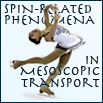Speaker
Guillaume Malpuech
Description
Monopoles are magnetic charges accelerating along a constant
magnetic field. They are absent in Maxwells equations
(contrary to electric charges) and have never been observed
as fundamental particles. The seminal work of Dirac [1]
showed nonetheless that monopoles are allowed by the laws of
quantum mechanics. Their non-observation has motivated the
search for monopole analogues in the form of quasiparticles
in solid-state systems. An alternative system where monopole
analogues have been predicted is a quantum fluid such as a
spinor Bose-Einstein condensate. In this case, monopoles
take the form of topological excitations combining phase and
spin geometries [3]. Condensates of microcavity polaritons –
quasiparticles arising from the strong coupling between
photons and excitons in a semiconductor structure, are an
ideal system to explore this phenomenon due to their unique
spin structure and the easy control of the polariton
wavefunction using optical techniques. Polariton condensates
have already provided experimental reports of fascinating
quantum fluid phenomena like superfluidity [4], oblique dark
solitons [5], or vortices and half-vortices [6].
In this work we show that the half-integer topological defects (half-solitons [7] or half-vortices) characterized by the presence of the topological defect in only one of the two spin components of a condensate behave as magnetic monopoles [8]. These defects show divergent spin textures, analogous to the field of a point electric charge, and behave like magnetic charges [3]. We provide a clear experimental observation of one of these excitations, half-solitons in a GaAs-based microcavity. Half-solitons are formed in the wake of a point-like barrier in the flow path of a polariton condensate created by resonant excitation with linearly polarized light. Studying the polarization of emission we provide the full spin tomography of these excitations and, by tracking their trajectory, we demonstrate that they behave as magnetic charges accelerated along an effective magnetic field due to the TE-TM splitting. These observations show that polariton condensates are an ideal system to study analogue physics.
[1] Dirac, Proc. Roy. Soc. A 133, 60 (1931).
[2] D. Solnyshkov et al., Phys. Rev. B 85, 073105 (2012).
[3] A. Amo et al., Nature Phys. 5, 805 (2009).
[4] A. Amo et al., Science 332, 1167 (2011).
[5] K. G. Lagoudakis et al., Nature Phys. 4, 706 (2008); K. G. Lagoudakis et al., Science 326, 974 (2009).
[6] H. Flayac et al., Phys. Rev. B 83, 193305 (2011).
In this work we show that the half-integer topological defects (half-solitons [7] or half-vortices) characterized by the presence of the topological defect in only one of the two spin components of a condensate behave as magnetic monopoles [8]. These defects show divergent spin textures, analogous to the field of a point electric charge, and behave like magnetic charges [3]. We provide a clear experimental observation of one of these excitations, half-solitons in a GaAs-based microcavity. Half-solitons are formed in the wake of a point-like barrier in the flow path of a polariton condensate created by resonant excitation with linearly polarized light. Studying the polarization of emission we provide the full spin tomography of these excitations and, by tracking their trajectory, we demonstrate that they behave as magnetic charges accelerated along an effective magnetic field due to the TE-TM splitting. These observations show that polariton condensates are an ideal system to study analogue physics.
[1] Dirac, Proc. Roy. Soc. A 133, 60 (1931).
[2] D. Solnyshkov et al., Phys. Rev. B 85, 073105 (2012).
[3] A. Amo et al., Nature Phys. 5, 805 (2009).
[4] A. Amo et al., Science 332, 1167 (2011).
[5] K. G. Lagoudakis et al., Nature Phys. 4, 706 (2008); K. G. Lagoudakis et al., Science 326, 974 (2009).
[6] H. Flayac et al., Phys. Rev. B 83, 193305 (2011).

